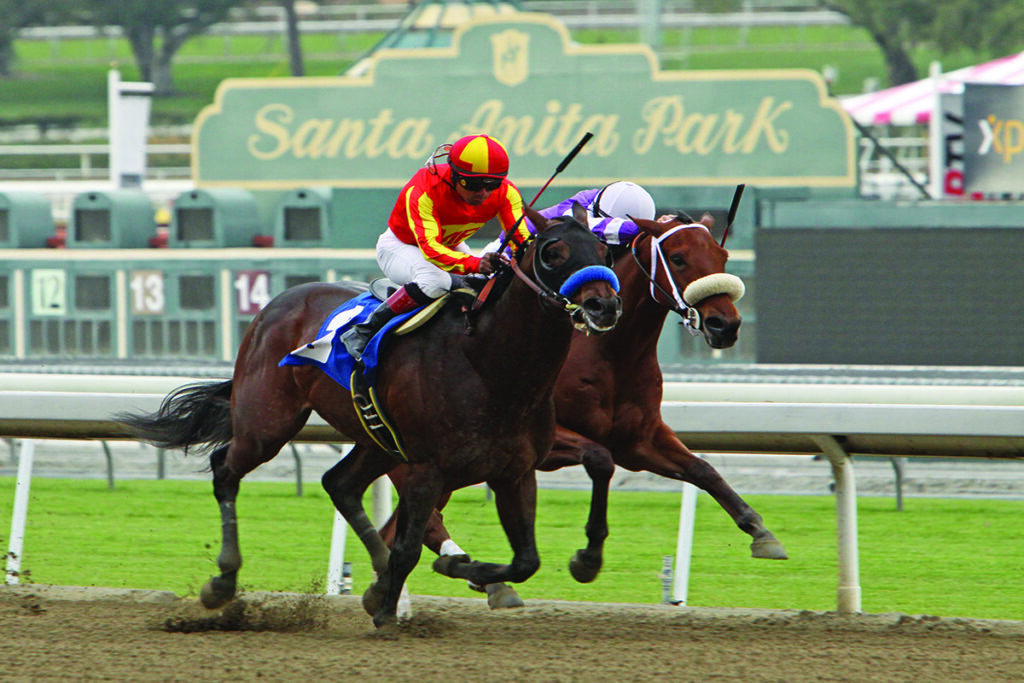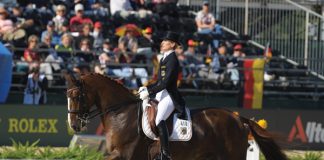“People just love the horses—they love to pet them and they love to watch them run,” says Fran Burns, head tour guide for Sunrise Tours at Baltimore’s Pimlico Race Course, owner at Boxwood Farms and a longtime Thoroughbred horse owner and advocate. “That’s why what happened at Santa Anita was so devastating to everyone—the race fans, the grooms, the trainers, and the people who love racing, because they love to see the horses.”

Official Investigations
Between the beginning of July 2018 and the end of June 2019, 49 horses either died or were euthanized as a result of injuries they sustained while training or racing at Santa Anita Park. Out of the 49 horses, 39 were attributed to catastrophic breakdowns during racing or training. The most equine fatalities took place between December 2018 and the end of March 2019, when a total of 25 horses died at the California racetrack.
In response, track operators asked Mick Peterson, Ph.D., director of Equine Programs and the Racetrack Safety Program and professor of Biosystems and Agricultural Engineering at the University of Kentucky, to thoroughly examine the surface conditions at Santa Anita. Peterson also serves as the executive director of the Racing Surfaces Testing Laboratory. His evaluation revealed that there was no track surface-related link to the fatalities.
Meanwhile, the California Horse Racing Board (CHRB) launched its own investigation into the deaths, and in April 2019, then-L.A. County District Attorney Jackie Lacey announced that her office had formed a task force to probe the incidents. That report absolved the operators of Santa Anita Park of wrongdoing in connection with the deaths.
Reforms
The series of deaths spawned reforms at Santa Anita, however. These ranged from the regular testing of the track’s surface to changing the way trainers get permission to work their horses.
Specifically, a team at Santa Anita that includes Peterson routinely conducts biomechanical tests. These involve a machine that mimics a galloping horse to collect data on deceleration, sliding, surface elasticity, and energy absorption.
In addition, ground penetrating radar is used to measure the depth of the surface layers every 10 centimeters along the track, and chemical and X-ray diffraction tests analyze track samples for density, moisture content, and mineralogical qualities.
Reforms also include strict limitations on the use of pain or anti-inflammatory medications, as well as treatments, such as joint injections, shockwave therapy, and anabolic steroids in horses.
Finally, trainers must apply for permission to work a horse in a timed, high-speed training exercise at least 48 hours in advance, and they must submit pre-entry vet forms before entering a horse for an upcoming race day so that the track’s veterinary staff have more time to identify any questionable horses.
The Role of Rain
Despite the new rules, some racehorse welfare advocates are still puzzled over the exact cause of the fatalities at Santa Anita in the first place.
“Was it the surface or the weather or the use of drugs?” Peterson asks. “I’d say all of the above.”
Before the track’s deadliest day was recorded, Santa Anita received 11½ inches of rain and had unusually cold temperatures. The wet weather hardened track surfaces, turning them potentially dangerous.
“Tracks are maintained by harrowing, grooming, and moisture control, but we had some bad weather—more than 11 inches of rain and cold temperatures in February 2019,” says Peterson. “Track surfaces became hard mostly due to the rain.”
This was documented by Peterson, who was involved in this investigation and who is still a consultant for Santa Anita.
Law Creates New Agency
The series of deaths at Santa Anita put the horse racing industry in the national spotlight, which resulted in the passage of HR 1754, the Horseracing Integrity and Safety Act of 2020. Signed into law in December 2020, the Act establishes the Horseracing Integrity and Safety Authority, a conflict-free, self-regulatory organization set up to create and implement an anti-doping policy for the entire horse racing industry.
In addition, the Act forbids the use of all medication within 24 hours of a race, and charges the Authority with developing a racetrack safety program to establish a uniform set of training and racing safety standards and protocols, including racetrack design and maintenance, and oversight of human and equine injury reporting and prevention.
The Act also charges the Authority with establishing procedures for undertaking investigations at racetrack and non-racetrack facilities related to safety violations, and requires sellers to provide full and fair information disclosures to buyers of racehorse breeding stock.
HR 1754 represents the first federal equine welfare legislation in 50 years, since the passing of the Horse Protection Act (HPA). The HPA was passed by Congress and subsequently signed into law by then-President Richard M. Nixon on Dec. 9, 1970, and criminalized soring, the deliberate injury to a horse’s feet or legs to achieve the high-stepping, so-called Big Lick gait seen in gaited horses.
Although long overdue, this next step in equine welfare protection is a positive sign of progress if the racing industry is to move forward.
This article about horse racing at Santa Anita originally appeared in the August 2021 issue of Horse Illustrated magazine. Click here to subscribe!





